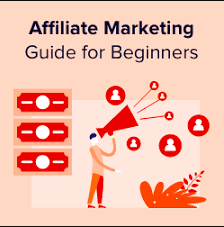Affiliate marketing is a powerful way to generate passive income online, but like any business model, it requires a strategic approach to succeed. If you’re a beginner looking to dive into affiliate marketing, it can feel overwhelming with the sheer number of options and platforms available. However, by following the right strategies, you can build a profitable affiliate marketing business over time. Here’s a guide to the best affiliate marketing strategies for beginners.
1. Choose the Right Niche
One of the first and most important decisions you’ll make is selecting your niche. Your niche will dictate the types of products you promote, your target audience, and how you approach content creation. It’s crucial to choose a niche that you’re passionate about but also one that has demand and monetization potential.
- How to Choose a Niche: Pick something that aligns with your interests, but also has proven demand. Popular affiliate marketing niches include health and wellness, personal finance, technology, beauty, and travel.
- Research Demand: Use tools like Google Trends or keyword research tools like Ahrefs and SEMrush to see what people are searching for within your chosen niche.
2. Start a Blog or Website
While you can promote affiliate products on various platforms (YouTube, Instagram, etc.), having a blog or website gives you full control over your content and SEO (search engine optimization). It’s a great long-term asset that can drive consistent traffic to your affiliate links.
- How to Start: You can easily start a blog or website with platforms like WordPress or Wix. Choose a domain name that reflects your niche and is easy to remember.
- Create Valuable Content: Focus on creating informative and helpful content that answers your audience’s questions and provides real value. This could be in the form of product reviews, how-to guides, or tutorials.
- Optimize for SEO: Learn basic SEO techniques to ensure your content ranks on search engines like Google. This involves optimizing your posts for keywords related to your niche.
3. Join Reputable Affiliate Programs
Not all affiliate programs are created equal. When you’re starting out, it’s important to join programs that offer products or services your audience would be interested in and that provide reliable commission structures.
- Popular Affiliate Networks:
- Amazon Associates: Perfect for beginners, Amazon has a vast selection of products and a trusted platform. However, their commission rates can be lower compared to others.
- ClickBank: Known for digital products, ClickBank offers higher commissions, sometimes up to 75%.
- ShareASale: A well-established affiliate network with a broad range of brands and products across different niches.
- CJ Affiliate: This network provides access to large brands like GoDaddy, Lowe’s, and more.
- How to Join: Visit the affiliate program’s website or join an affiliate network to apply. Ensure you thoroughly read the program’s terms and conditions, especially regarding payment methods and commission rates.
4. Leverage Email Marketing
Email marketing is a powerful tool in affiliate marketing because it helps build relationships with your audience and increases the likelihood of conversions. You can send targeted promotions, new content updates, and special offers directly to your subscribers’ inboxes.
- How to Build an Email List: Use tools like ConvertKit, Mailchimp, or Aweber to set up email collection forms on your website. Offer a lead magnet like an e-book, checklist, or free course to incentivize visitors to subscribe.
- Segment Your Audience: Once you have a list, segment your audience based on their interests. This allows you to send more personalized affiliate offers, increasing your chances of making a sale.
- Automate Emails: Set up email sequences (or autoresponders) to send content and affiliate promotions over time. For example, you can create a welcome series or follow-up emails to nurture leads.
5. Create High-Quality Content That Solves Problems
Content is the cornerstone of affiliate marketing. You need to create high-quality, helpful, and engaging content that resonates with your audience. This will help build trust and authority, making it easier to promote affiliate products effectively.
- Focus on Value: Rather than directly pushing products, aim to solve your audience’s problems or provide them with valuable information. For example, write “how-to” guides, tutorials, or comparison articles that demonstrate the value of the products you’re promoting.
- Types of Content:
- Product Reviews: Write detailed, honest reviews of products in your niche. Make sure to highlight both the pros and cons, as transparency builds trust.
- Listicles: Create round-up lists like “Top 10 Best [Product]” or “Best Tools for [Task].” These types of posts tend to rank well and attract clicks.
- Tutorials & Guides: Create step-by-step guides that show how to use a product or service, emphasizing the benefits and why it’s a good choice.
6. Use Social Media to Drive Traffic
Social media platforms like Instagram, Facebook, Pinterest, and Twitter offer great opportunities to promote affiliate products. While it’s harder to directly monetize social media accounts compared to a website, they can still be valuable for driving traffic to your affiliate offers.
- Instagram: Share engaging posts, stories, and reels related to your niche. Use affiliate links in your bio or stories if you have over 10,000 followers. You can also promote products using affiliate codes or links in your posts.
- Pinterest: Pinterest is excellent for affiliate marketers because it functions as a visual search engine. Create pins that link back to your blog posts or product pages and drive traffic to your affiliate links.
- Facebook & Twitter: Share your blog posts and promote affiliate offers through organic posts or in relevant groups.
7. Track and Optimize Your Campaigns
To be successful in affiliate marketing, you need to track your performance and continuously optimize your efforts. Use tracking tools and analytics to understand which content and affiliate links are performing best.
- Use Tracking Links: Platforms like Bitly or Google Analytics can help you track how many clicks and conversions your affiliate links are getting. This helps you identify what’s working and what’s not.
- Test and Optimize: Regularly test different types of content, affiliate products, and promotional strategies to see what generates the best results. You can tweak headlines, call-to-action buttons, or change affiliate offers to improve your conversion rates.
8. Diversify Your Affiliate Partnerships
While focusing on a few affiliate programs is a great start, it’s important not to put all your eggs in one basket. Diversifying your affiliate partnerships gives you access to different income sources and protects you if one program reduces its commissions or terms change.
- Work with Multiple Brands: Alongside larger affiliate networks like Amazon and ClickBank, consider reaching out to individual companies within your niche for private affiliate deals.
- Promote Different Types of Products: Mix up the types of affiliate products you promote, such as physical products, digital products, and services. Offering a variety of options can increase the likelihood of conversions.
9. Focus on Long-Term Growth
Affiliate marketing success doesn’t happen overnight. It takes time to build an audience, create content, and start generating consistent income. Patience is key.
- Stay Consistent: Keep publishing new content regularly, even if you don’t see immediate results. Over time, your blog or website will accumulate traffic, and your affiliate income will grow.
- Scale Up: Once you start seeing some success, scale up by adding more content, reaching out to more affiliate programs, or investing in paid ads to drive more targeted traffic to your content.
10. Be Transparent and Build Trust
In affiliate marketing, trust is everything. Your audience needs to know that you’re recommending products you genuinely believe in. Always be transparent about your affiliate relationships and only promote products that align with your values.
- Disclose Affiliate Links: Legally, you must disclose that you’re using affiliate links. It’s also a good practice to maintain transparency to ensure your audience trusts your recommendations.
- Honesty is Key: Don’t promote products just for the sake of commissions. Instead, focus on promoting products that will genuinely benefit your audience and solve their problems.
Conclusion
Affiliate marketing can be a rewarding venture for beginners, but success doesn’t happen overnight. By choosing the right niche, creating high-quality content, joining reputable affiliate programs, and building trust with your audience, you can lay the foundation for a profitable affiliate marketing business. Remember, consistency, patience, and a commitment to providing value will go a long way in helping you succeed in this field. Happy affiliate marketing!



